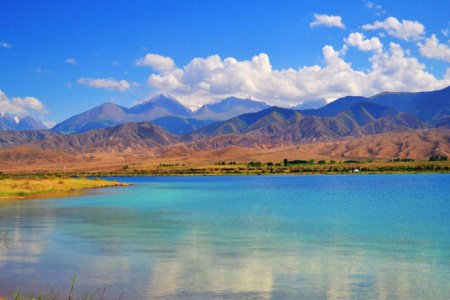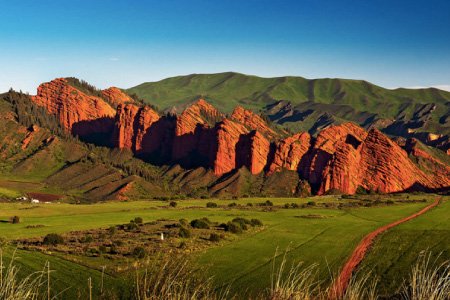Here is a glimpse of the best tourist places for a surreal vacation in this Asian country in order to plan your next holiday and activities in the beautiful country of Kyrgyzstan also known as the “Switzerland of Central Asia”.
Best Time To Visit Kyrgyzstan
Situated in the Central of Asia, Kyrgyzstan has very cold winters and hot summers. The winter season in Kyrgyzstan is from November to March and the summer is from June to October. During the winters, due to snow, many routes are hindered, and there is snow covering everything, so the summers are the best times to visit Kyrgyzstan as this weather is ideal for horse riding, cycling, rafting, hiking, and sightseeing. However, if one is interested in skiing and other winter sports, then visiting Kyrgyzstan in winter can be chosen.
Ala Archa Gorge

This grand, rugged but very accessible gorge is situated about an hour’s drive south of Bishkek. Now converted into a national park, it offers scores of walking and trekking possibilities, including hikes to glaciers and for serious mountaineers, climbs to some of the region’s highest peaks.
In the Kyrgyz language, Ala-Archa means bright juniper and it grows in abundance over the mountain slopes. The Alamedin River, flowing along the gorge is beautiful but treacherous. Ala-Archa national park is a favourite place with the citizens of Bishkek, who like to relax by a waterfall and enjoy a picnic in the summer. Experienced hikers can climb up to the stunning Ak Say Canyon and Ak Say Glacier.
Lake Issyk Kul meaning “warm lake” is the second largest mountain lake in the world and Kyrgyzstan’s largest lake. It lies at an altitude of 1,600 m in the high mountain range of Tien-Shan (Heaven’s mountains) in the north of Kyrgyzstan. Measuring 182km long by 58km wide, the lake is heated from below by thermal activity and numerous warm spring, hence it never freezes even in the depths of winter.
In Kyrgyz Issyk-Kul means hot lake. At the southern shore there is the Tien-Shan mountain range with high peaks of over 7,000 m and the longest glaciers of the world outside of the polar region. Characteristic are the high mountain valleys, the so called syrts, high mountain mats with rich flower-bloom and the vast high plateaus with traditional pasture.
Lake Issyk Kul

Tien Shan

The Tien Shan, or Celestial Mountains, are one of the most beautiful mountain ranges on earth. The colour, variety, shapes and simple wildness of the Tien Shan will have you buzzing with wonder. You can live with nomads in their yurts and camp by wild rivers in forests of pine. Miles away from ‘civilisation’, after a few days in the Tien Shan will feel like a nomad yourself!
Osh is Kyrgyzstan’s second largest city. It is one of the region’s most ancient towns with a history stretching back to the 5th century BC and legends tell of it being founded by all sorts of people from King Solomon to Alexander the Great. It was a major hub on the Silk Road. Today it has a strong Uzbek feel which is unsurprising as 40% of the population are Uzbeks. The huge daily Jayma Bazaar is one of Central Asia’s best markets, it is spread out along the river and is at its busiest on Sunday. Just outside the town is a rocky outcrop known as Solomon’s Throne. It has long been a place of Muslim pilgrimage as Mohammed is supposed to have once prayed here.
Osh

Karakol

Karakol is the administrative center of the Issyk-Kul region. However although it isn’t located right on the shores of the lake, it’s easy to make day trips to the lake or to the nearby mountains. In the 19th century, it became a strategic point separating Russian Empire from China. Today the town is famous for its surrounding apple orchards and there is a very good Sunday market. Things to see include the beautiful Chinese mosque, which was built entirely without nails by Chinese artisans in 1920, and the Holy Trinity Cathedral. There are also good walks to be had in the valley of the Karakol River.
Sheltering in the lee of a black granite cliff, in what must surely be one of the prettiest valleys in the country, this ancient Silk Road caravanserai, constructed of dark stone with a huge arched entrance, domed roof and corner turrets, appears like some ancient eastern castle, a mythical outpost from some long-forgotten legend. Tash Rabat is a historic stone caravanserai. These were places used by merchants and their caravans on the ancient Silk Road. It is one of the best preserved of such places in Central Asia. You can sleep in yurts nearby or go horse riding. It was originally built as a Nestorian monastery and then turned into a caravanserai.
Tash Rabat

Jeti-Oguz Gorge

Picturesque Jeti-Oguz gorge is located 28 kilometers to the south-west of the town of Karakol. Its name is translated from Kyrgyz language means “Seven bulls”. The name is symbolic, because there is a 35 km long wall of seven huge red-brown cliffs resembling ranked furious bulls standing together.
In front of the cliffs there are flat mountain slopes, thickly overgrown with grass and pine trees. Especially romantic look has the rock “Broken Heart” located at the entrance to the gorge. Jeti-Oguz is also famous for its hot springs with water enriched with radon and hydrogen sulfide and resorts.
The water in springs is helpful for the treatment of rheumatism, gastric and nervous diseases. Rising higher, you can reach the pan of Kok-Dzhayyk with wonderful views of the gorge, or the Valley of Flowers strewn with poppies. At the upper part of Jets-Oguz there are also mountain lakes and roaring waterfalls.
Son Kul Lake is a large alpine lake located in the Tian Shan mountain range, north-west of Naryn. It’s a great destination go hiking or horseback riding and to discover breath-taking landscapes, inhabited only by a few Kyrgyz nomads who come with their herds in the sunny days.
The Son Kul Lake is a high-mountain lake located at around 3,000 m (9,842 ft) above sea level. It stretches over 275 km² with a maximum depth of 15 m (49 ft). Frozen for more than half of the year, the lake and its arid surroundings welcome nomadic shepherds and their herds only during the warm season, usually from June to September.
Son Kul Lake

